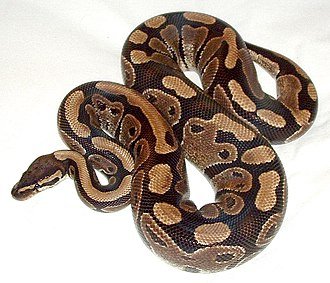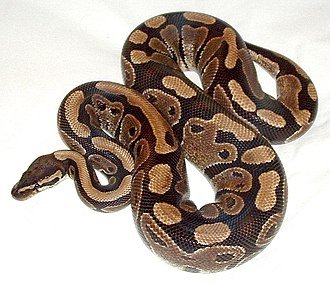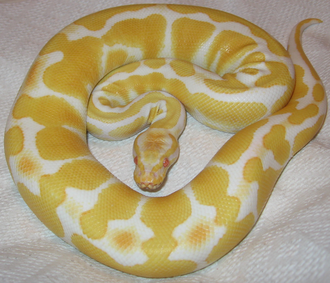
The topic of ball python care and its importance in ensuring the well-being of these reptiles:
- Emphasize the responsibility that comes with owning a ball python and the importance of understanding their specific care needs.
Be aware that ball pythons, like any living creature, have unique needs that must be met to ensure their physical and mental well-being.
Discuss how proper care contributes to a ball python’s overall health, happiness, and longevity. - Address the fact that ball pythons have specific habitat requirements, including temperature, humidity, and substrate preferences, that need to be provided for in captivity.
- Highlight the importance of creating a suitable enclosure that mimics their natural environment, as this promotes their overall well-being and reduces stress.
Explain that proper nutrition is important for ball pythons, and a balanced diet consisting of suitable prey items is essential for their growth, development, and overall health. - Discuss the importance of maintaining clean and hygienic conditions within the enclosure to prevent the occurrence of diseases or infections.
Note the need for regular monitoring of their health including observing their eating habits, shedding patterns, and overall behavior. - Explain that handling ball pythons properly while minimizing stress can help promote socialization and build trust between the snake and its owner.
Discuss the possible negative consequences of inadequate care, such as deficiencies or obesity due to improper nutrition, sub-optimal living conditions causing stress-related issues, or neglect of health concerns leading to more serious illnesses.
An overview of ball pythons as a species, including their natural habitat, behavior, and lifespan:
- Describe the natural habitat of ball pythons, highlighting their native regions in sub-Saharan Africa such as countries such as Ghana, Togo, and Benin.
Explain the typical environments where ball pythons are found in the wild, such as savannas, grasslands, and forest edges. Discuss the importance of providing similar housing within their captivity. - Discuss the physical characteristics of ball pythons, including their average size, which can range from 3 to 5 feet for males and 4 to 6 feet for females. Mention their relatively modest weight, typically between 2.5 and 4.5 kg.
- Explain the distinctive color and pattern variations found in ball pythons, such as the distinctive brown or black background coloration with the distinctive spots or “ball” pattern that gives them their name.
- Address the ball python’s behavior, emphasizing their generally docile and calm nature. Mention their tendency to turn the ball over when forced or threatened, which is typical defensive behavior.
- Discuss the unique feeding behavior of ball pythons, which are constrictor snakes. Explain how they capture and subdue their prey by wrapping and squeezing their prey around themselves until it suffocates.
- Mention the lifespan of ball pythons, which with proper care and husbandry practices can be 20 to 30 years or more in captivity. Highlight the importance of being committed to the long-term care of ball pythons.

Requirements for a suitable ball python enclosure including appropriate size, enclosure type, and substrate choices:
- Address the importance of providing an enclosure of sufficient size for a ball python to allow for movement and exploration. Recommend a minimum enclosure size of 36 inches in length, 18 inches in width, and 12 inches in height for juveniles, while adult ball pythons may require a larger enclosure, such as 48 inches or more in length.
- Discuss the types of enclosures suitable for ball pythons, such as glass terrariums, plastic reptile cages, or PVC enclosures. Explain the advantages and disadvantages of each type, considering factors such as insulation, visibility, and ease of maintenance.
Explain the need for a secure enclosure with a tight-fitting lid or door to prevent escape. Discuss the importance of using a locking mechanism, especially for larger or more active ball pythons. - Discuss the importance of providing suitable heating and lighting elements within the enclosure, such as under-tank heating pads or ceramic heat emitters. Explain the need to create a thermal gradient, so that a snake can regulate its body temperature by moving between warm and cold areas.
- Address the importance of maintaining appropriate humidity levels within the enclosure, typically between 50% and 60%. Recommend the use of a hygrometer to monitor humidity and discuss ways to increase or decrease humidity as needed, such as using mist or a humidity box.
- Explain the different substrate options available for ball python enclosures, such as aspen bedding, cypress mulch, coconut fiber, or reptile carpet. Discuss the pros and cons of each substrate type, considering factors such as moisture retention, ease of cleaning, and likelihood of ingress.
- Highlight the importance of providing suitable hiding places such as caves or branches within the enclosure to create a sense of security for the ball python. Discuss the benefits of having multiple hiding places in different areas of the enclosure.
Note the need for regular cleaning and maintenance of the compound, including periodic deep cleaning of the waste area to maintain cleanliness and hygiene.

The dietary needs of ball pythons, including the type of prey they prey on and the frequency of eating:
- Discuss the natural diet of ball pythons in the wild, which consists mainly of small mammals such as mice, rats, and occasionally birds. In captivity, it is common to feed them pre-killed or frozen-thawed prey items.
- Explain the importance of offering appropriately sized prey items that match the snake’s girth. Discuss the different sizes of prey, such as pinky rats, fuzzy rats, hoppers, weanlings, and small mice, depending on the age and size of the ball python.
- Address the need for a varied diet to ensure nutritional balance. Discuss the benefits of offering a variety of prey, such as mice, rats, or chicks, to provide a range of nutrients and prevent nutritional deficiencies.
- Explain the frequency of feedings based on the age and size of the ball python. For juveniles, recommend feeding every 5 to 7 days, gradually increasing the interval to 7 to 10 days for sub-adults, and finally settling at about 10 to 14 days for adults. Emphasize the importance of monitoring the snake’s body condition and adjusting feeding frequency accordingly.
- Discuss the feeding procedure, including the appropriate method for thawing and heating frozen prey items before offering them to the ball python. Highlight the need to ensure the prey is at an appropriate temperature to mimic the heat of live prey.
- Address the importance of supervised feeding to prevent accidental injury to the ball python during the feeding process. Explain that feeding should be done in a separate enclosure or feeding box to associate food with a specific area and reduce stress.
- Mention the importance of allowing the ball python to digest its food undisturbed. Discuss the need to provide a warm and safe hiding place for the snake to retreat to after feeding.
- Highlight the importance of monitoring the ball python’s weight and body condition to ensure it maintains a healthy shape and does not become underweight or overweight.
Health problems that ball pythons may face, such as respiratory infections, weaning difficulties, and parasites:
- Discuss respiratory infections as one of the most common health problems in ball pythons. Explain that respiratory infections can be caused by factors such as inadequate temperature and humidity levels, poor ventilation, or exposure to drafts. Highlight signs to watch for, such as wheezing, open-mouth breathing, excessive mucus, or loss of appetite, and emphasize the importance of seeking veterinary care when these signs are observed.
- Explain how to overcome problems that ball pythons may experience, such as retaining an incomplete shed or eye cap. Discuss causes, such as insufficient humidity or dehydration, and explain the importance of maintaining proper humidity levels during the shedding process. Offer tips to assist the snake during shedding, such as providing a humidity box or gently moistening the skin if necessary.
- Address the presence of external and internal parasites that can affect ball pythons. Discuss common parasites such as mites, ticks, and internal worms. Explain the importance of regular monitoring and preventive measures, such as quarantine procedures for new additions to the collection and regular fecal examinations by a veterinarian. Highlight the importance of prompt treatment if parasites are found, and provide information on proper treatment under the guidance of a reptile-experienced veterinarian.
- Discuss the potential impact of poor husbandry practices on the ball python’s overall health, such as issues related to stress, obesity, or metabolic bone disease. Emphasize the importance of a suitable environment, proper nutrition, and regular veterinary checkups to prevent these health concerns.
Mention the importance of regularly observing the snake’s behavior, appetite, and body condition for any signs of illness or distress. Encourage readers to establish a relationship with a reptile-experienced veterinarian who can provide guidance and medical care for their ball python.
Ball python reproduction, including ideal conditions for breeding and the process of egg-laying and incubation:
- Explain the concept of reproductive readiness in ball pythons, emphasizing the importance of reaching sexual maturity before attempting to breed. Discuss the typical age and size at which a ball python is considered sexually mature, which is usually around 2 to 3 years old and weighs at least 1,000 grams.
- Discuss the importance of creating ideal conditions for breeding, including providing a cooling period known as “brumation” to mimic seasonal changes in their natural habitat. Explain recommended temperature and light cycle adjustments during the chilling period, which usually lasts about 2 to 3 months.
- Address the importance of introducing compatible breeding pairs and allowing them to engage in the courtship process. Explain the behavior displayed by males and females during courtship, such as the male’s attempts to arouse the female and the acceptance or rejection response of the female.
- Discuss the process of copulation between male and female ball pythons, emphasizing the need for careful monitoring and ensuring that both snakes are in good health and not under excessive stress during the breeding process.
- Explain the process of ovulation and egg laying in a female ball python. Discuss the signs of ovulation, such as weight gain and loss of appetite, and the timing of ovulation, which usually occurs within 30 to 45 days after ovulation.
- Address the importance of providing appropriate egg-laying options such as nesting boxes or humidified hide boxes filled with suitable substrate to facilitate the egg-laying process. Discuss the importance of maintaining proper moisture levels to prevent dehydration of eggs.
- Explain the process of carefully collecting the laid eggs and transferring them to an incubation container. Discuss a suitable substrate, such as vermiculite or perlite, and the ideal temperature and humidity levels needed for successful incubation.
- Highlight the incubation period for ball python eggs, which typically ranges from 55 to 75 days, depending on a variety of factors such as temperature and genetics. Explain the importance of regular monitoring during incubation to ensure optimal conditions for embryo development.
- Discuss the process of hatching and the importance of providing proper post-hatching care, including proper temperature, humidity, and food for the newborn ball python.
Addressing common questions and concerns that new ball python owners may have, such as lifespan, handling frequency, and shedding
- Discuss the average lifespan of a ball python in captivity, which is usually 20 to 30 years with proper care. Emphasize the importance of a suitable environment, balanced nutrition, and regular veterinary checkups to ensure a long and healthy life for the snake.
- Address the question of handling frequency and explain that ball pythons generally prefer a quiet and secure environment. Recommend a gradual and gentle approach to handling, especially when first introducing the snake to its new home. Emphasize the importance of allowing the snake to settle down and relax before gradually increasing handling sessions. Discuss the benefits of handling, such as socialization and monitoring of the snake’s health, but also stress the importance of respecting the snake’s individual temperament and preferences.
- Explain the shedding process and common concerns related to shedding difficulties in ball pythons. Discuss signs of an impending shed, such as discolored or cloudy eyes and a milky appearance to the skin, and explain that factors such as low moisture or dehydration can cause shedding difficulties. Offer tips to assist the snake during shedding, such as providing a humidity box or gently moistening the skin if necessary.
- Address common food-related concerns, such as refusal to eat or selective feeding. Discuss possible causes of eating problems, such as stress, improper parenting, or seasonal appetite changes. Provide guidance on troubleshooting feeding problems, such as ensuring appropriate prey size, offering a variety of prey, and creating an appropriate feeding environment.
- Discuss common health concerns and when it is appropriate to seek veterinary care. Provide guidance for monitoring the snake’s behavior, appetite, and body condition and explain that any significant changes or signs of illness should be addressed promptly by a reptile-experienced veterinarian.
- Address questions related to ball python growth and size, explaining that when they are small as hatchlings, they can grow to an average length of 3 to 5 feet for males and 4 to 6 feet for females. Are. Explain that individual growth rates can vary, and genetics can also affect snake size.
- Discuss other frequently asked questions or concerns that new ball python owners may have, such as temperature and humidity requirements, suitable enclosure, environmental enrichment, and interactions with other pets or animals.
- By addressing common questions and concerns of new ball python owners, such as lifespan, handling frequency, and shedding, readers can gain a better understanding of how to care for their ball python and address potential issues. This information helps new owners provide a suitable and enriching environment for their snakes, promoting their well-being and fostering a positive owner-pet relationship.
